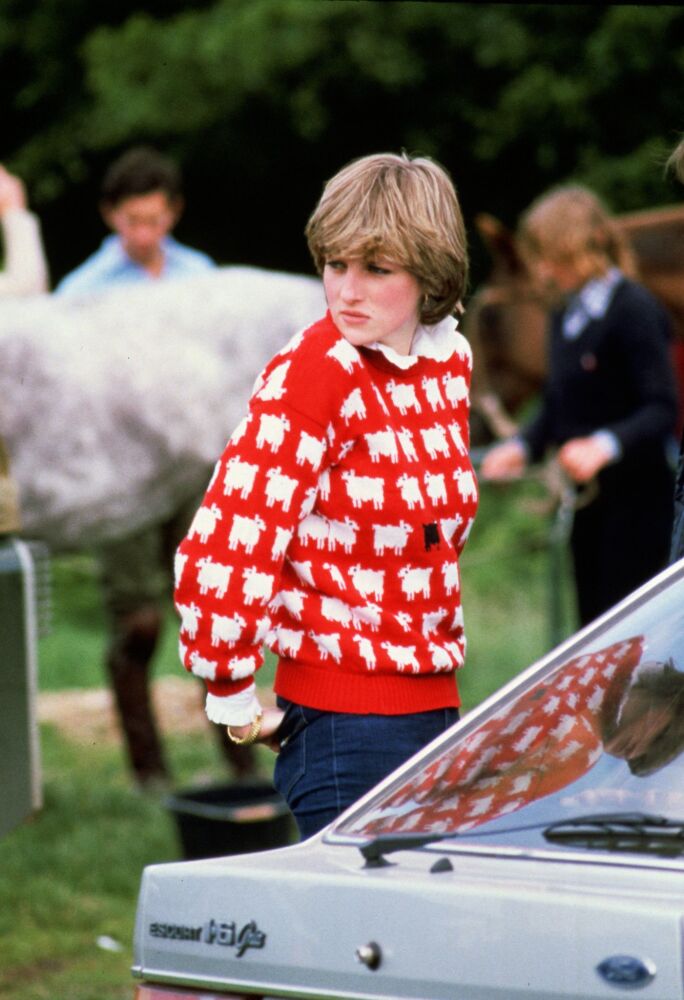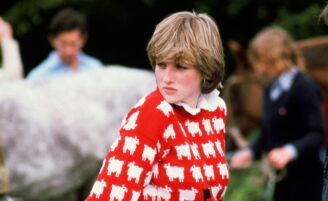T he story of Diana, Princess of Wales, has been told so many times, refracted through the cultural lens of the day, documented by countless auteurs, embodied by the waiflike blond actress of the moment. Every single portrayal, portrait or biography, however, has one thing in common: an obsessive focus on her iconic, inimitable style.
And it all began with, or rather after, Diana’s sheep sweater.
Yes, technically, there were fashion moments before – the sheer skirt fiasco, the soft periwinkle-blue engagement suit, the heirloom sapphire engagement ring – but it was her guileless choice of a wool intarsia-knit sweater by a small brand called Warm & Wonderful, worn to a polo match in June of 1981, that has stuck so indelibly in our collective memories.
Worn after her engagement but before her wedding, the “one black sheep” sweater (or jumper, in British parlance) is an unusual addition to the collection of pieces formerly owned by the Princess that have come to the auction market. Unlike most of the items we’ve seen pass through the hands of lucky collectors and museums in the twenty-five-plus years since her death, the sweater came before so much of the turmoil that ultimately defined Diana’s life.

At the time of the polo match, public interest in her was high but not yet a frothing, insatiable churn. Diana’s fashion choices couldn’t send fans into a shopping frenzy like Princess Catherine’s do now (high street dresses worn by Catherine are still known to sell out within hours of her wearing them publicly). Joanna Osborne and Sally Muir, the young women behind the knitwear brand that had created the sweater, barely even saw an uplift in sales at first.
“No one really knew it was ours and there was no way to tell them,” Osborne tells Sotheby’s. “It absolutely put us on the map” – David Bowie and Andy Warhol were among the famous names who subsequently bought sheep sweaters – “but it didn’t have quite the significance that it has now.”
It probably didn’t have quite the significance to then-Lady Diana either. She was almost literally still a child (at the time of the polo match, she was just 19 years old), albeit one who was set to marry the future king in a month. “Probably, at that stage, she didn’t realize she could say things with her clothes,” says Muir. “It was just a fun sweater that she liked.”
Princess Diana’s black sheep sweater visits TODAY before auction

“It’s an obvious metaphor for not quite fitting in. But also, that it’s okay to stand out and be different.”
But Diana’s innocence wouldn’t last very long at all. “Her entry into the royal fashion conversation came at the same time when the media landscape was exploding,” says Elizabeth Holmes, a Los Angeles-based writer and author of HRH: So Many Thoughts on Royal Style. “Suddenly there were glossy magazines that needed pictures to run and TV news networks that needed things to talk about – and here was this beautiful young princess to be.”
Diana very quickly realized that she needed a hand with her style, tapping editors at British Vogue to assist with a makeover. But it wasn’t until after her marriage that she began to truly speak through her clothes. “A couple years made a huge difference in her life,” Holmes says. “She got married and the royal family expected the attention to die off. And it didn’t.”

Two years after the first outing of the sheep sweater, she very famously wore it again to yet another polo match, this time with white jeans, a peter pan collar with a long black bow. “It’s an obvious metaphor for not quite fitting in,” says Cynthia Houlton, SVP and Global Head of Fashion and Accessories at Sotheby’s about this second appearance. “But also, that it’s okay to stand out and be different.”
“When she wore the second sweater, she knew exactly what she was doing,” Holmes says. In the short years since her wedding, her marriage had already grown cold and Diana, who met Charles only 13 times before they were wed, reportedly felt lonely and out of step with the strict mores of Buckingham Palace. “The black bow – if you look at the tails, they go right down to the black sheep. She knows exactly what people are paying attention to. And she’s playing to that.”
The second wearing was also doubly impactful for Warm & Wonderful, which was still a small business operating out of a combo studio/storefront in the London borough of Wandsworth. “The press knew who we were by then, then we had a big piece in People magazine that really launched us in America,” Muir says. Though they are not aware of Diana ever purchasing anything from them again (and they believe that the first sweater was a gift from the mother of a page boy in her wedding), they received orders from others in the royal family and started shipping abroad.
“It’s not trying to be sophisticated or subtle or something that a truly grown-up woman would have worn. But it speaks to where Diana was in that moment.”
The attention and the focus became almost a burden for Muir and Osborne, who were keen to be taken seriously as designers and artists, not pigeonholed as the sheep-sweater girls. “We didn’t just want to do that one thing forever,” Muir says. “We were grateful, but we wanted to move on.”
Perhaps this desire to shed the sheep mantle once and for all is why the first sweater, sent back for repair after a cuff was damaged, never made it back and was forgotten for decades in Osborne’s attic.
It’s that first, original sweater that’s coming up for auction in Sotheby’s Fashion Icons as part of The Luxury Edit this September. But the fact of its replacement didn’t come to light until very recently.
As the story goes, Buckingham Palace sent the original sweater back to Warm & Wonderful with a request for a repair. After inspecting the garment, Osborne and Muir decided it would be best to simply send her a new one (keen eyes will notice that the placement of the black sheep is slightly different).
The switcheroo adds an element of delight to the first sweater because it was worn with a decidedly different intent. In fact, it is perhaps precisely because it isn’t a revenge dress or an insouciant branded sweatshirt or knee-baring, royal dress-code flouting mini skirt, that this sweater is so special. It came before the Bruce Oldfield gowns and Catherine Walker dress coats, before the necklace worn as a headband and the twirl with John Travolta.
It came before the infidelity and the next generation of princes and the divorce. The sweater was a meaningless childish choice until, two years later, it was imbued with new resonance. “It’s not trying to be sophisticated or subtle or something that a truly grown-up woman would have worn,” Holmes says. “But it speaks to where Diana was in that moment.”
For those of us who love Diana, the idea of owning something that the People’s Princess wore and loved enough to have repaired, is a heady proposition. And, unlike the gowns and the eighties-style padded shoulder suits that have come before, the sweater is undeniably wearable. (For those who want to wear the style but not the original, Warm & Wonderful has partnered with Rowing Blazers on a cotton replica.) But the idea of owning something of Diana’s before she was the princess of legend? That’s another thing entirely.

When Osborne found it in her attic after 40 years, it was “rolled up in a ball,” packed in a “wine box” alongside cotton bed sheets rather than embalmed in acid-free paper or encased in glass. Part of the reason they were keen to auction it is because they couldn’t believe their luck that it had survived so well preserved.
“You know when you wear a sweater and the arm rubs against the side, and it pills slightly?” Muir says. “This sweater has some wear, just like that.” Otherwise, it was untouched by time – and moths (the truest blessing).
“When you’re a royal, you have access to any fashion you possibly want,” says Sotheby’s Houlton. “She didn’t need that sweater; she didn’t need to replace it. It’s not Chanel; it’s not custom. Not only did she want it replaced, but two years later she actually wore it.” It’s a truly beloved article of clothing worn by a young woman who, in the years to come, would come to revere and utilize fashion with surgical skill, but also to have fun with it.
“How amazing would it be for someone to buy it and wear it,” Holmes says. “That’s such a Diana thing to do.”







